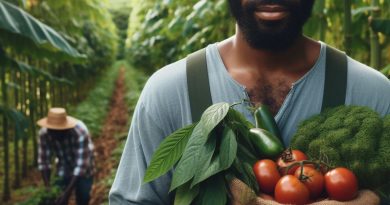Small Farm, Big Debt: A Financial Saga
Last Updated on March 1, 2024
Introduction
Brief overview of the small farm industry
The small farm industry plays a pivotal role in sustaining local economies, fostering community resilience, and ensuring food security.
These small-scale agricultural operations are often the backbone of rural areas, providing not only essential goods but also contributing to the cultural fabric of the regions they inhabit.
The challenges faced by small farmers
However, despite their importance, small farmers face a myriad of challenges that threaten their livelihoods.
One of the most significant hurdles is the relentless pressure of market competition.
Large agribusinesses dominate the market, leveraging economies of scale and sophisticated supply chains to outpace smaller operations.
This leaves small farmers struggling to find their footing in an increasingly crowded and unforgiving marketplace.
Introduce the concept of debt and financial struggles
Moreover, small farmers grapple with mounting financial burdens and debt.
In an industry where profit margins are slim and unpredictable, even minor setbacks can have devastating consequences.
From fluctuating commodity prices to unpredictable weather patterns, small farmers are constantly at the mercy of external forces beyond their control.
As they strive to keep their operations afloat, many find themselves trapped in a vicious cycle of borrowing and indebtedness.
The concept of debt looms large over small farms, casting a shadow of uncertainty and instability.
Whether it’s loans taken out to purchase equipment, finance expansion projects, or simply cover day-to-day expenses, debt can quickly spiral out of control, leaving farmers drowning in financial distress.
With limited access to capital and resources, small farmers often find themselves trapped in a precarious situation, struggling to make ends meet while navigating a complex web of financial obligations.
In the following section, we will delve deeper into the specific challenges facing small farmers and explore the various factors contributing to their financial struggles.
From the pressures of globalization to the inadequacies of government support programs, we will examine the root causes of small farm debt and explore potential solutions to alleviate the burden on those who tirelessly toil the land to feed their communities.
The Rising Costs of Farming
Farming used to be synonymous with a simple and humble lifestyle, but in recent years, the agricultural industry has undergone significant changes.
These changes have led to a rise in the costs of farming, creating a financial saga for many small farmers.
The increasing costs of land acquisition
One of the most notable challenges faced by small farmers is the increasing costs of land acquisition.
With land prices skyrocketing, it has become incredibly challenging for small farmers to expand their operations or even start anew.
Non-agricultural industries’ demand for land has led to its inflated value, leaving small farmers with limited options in securing affordable land.
This situation puts them at a significant disadvantage in the agricultural market, as they struggle to compete with larger corporations.
The expenses involved in equipment and machinery
Another financial obstacle for small farmers is the high expenses involved in equipment and machinery.
Modern farming practices heavily rely on expensive equipment and machinery, such as tractors and combines.
The initial purchase and subsequent maintenance of these tools require a substantial financial investment, which many small farms are unable to afford.
Moreover, the constant need to upgrade equipment puts additional strain on their already limited finances.
The financial burden of crop inputs and supplies
Furthermore, the financial burden of crop inputs and supplies adds to the challenges faced by small farmers.
Fertilizers, pesticides, and seeds are essential for successful farming, but their prices have been steadily increasing.
Small farmers, lacking the bargaining power of larger commercial farms, bear the brunt of these rising costs.
To afford necessary crop inputs and supplies, many small farmers are forced to take on debt, further exacerbating their financial burdens.
Consequently, the rising costs of farming have created a highly challenging environment for small farmers.
Land acquisition has become increasingly unaffordable, restricting their ability to expand or establish new farms.
The expenses involved in equipment and machinery put them at a disadvantage in adopting modern farming practices.
Additionally, the escalating costs of crop inputs and supplies, coupled with the need to accumulate debt, further strain their financial wellbeing.
As the financial saga continues, it is crucial to address these issues and find sustainable solutions to support small farmers and preserve the vitality of the agricultural sector.
Read: Trailblazing Women: Stories from the Farm Fields
Farming Income: The Realities
Fluctuations in agricultural prices
- Agricultural prices are highly volatile, influenced by factors such as weather conditions, supply and demand, and global market trends.
- Farmers must constantly monitor and analyze market conditions to make informed decisions about their production and pricing strategies.
- Fluctuations in agricultural prices can significantly impact a small farmer’s income, making financial planning and risk management crucial.
- Understanding market trends and diversifying crops can help farmers mitigate the risks associated with price fluctuations.
- Collaboration with cooperatives or farmer’s associations can provide small farmers with better negotiating power in dealing with buyers.
The challenges of marketing and selling farm products
- Small farmers often face difficulties in marketing and selling their farm products due to limited resources and competition.
- Establishing a reliable distribution network can be costly and time-consuming for small-scale farmers.
- Lack of marketing knowledge and skills may prevent farmers from effectively promoting their products in the market.
- Finding buyers who are willing to pay fair prices for quality produce can also be a challenge for small farmers.
- Direct marketing strategies such as farmers’ markets, community-supported agriculture, and online platforms can help small farmers reach consumers directly.
The limited income opportunities for small farmers
- Small farmers often face limited income opportunities due to various factors.
- Low economies of scale make it difficult for small farmers to compete with larger agricultural operations.
- Government policies and subsidies may favor larger farms, leaving small farmers at a disadvantage.
- Access to credit and loans is often limited for small farmers, hindering their ability to invest in their operations or expand their business.
- Income fluctuations and unpredictable market conditions further compound the financial challenges small farmers face.
In fact, farming income for small farmers is a complex and challenging aspect of their agricultural journey.
Fluctuations in agricultural prices, difficulties in marketing and selling farm products, and limited income opportunities all contribute to their financial struggles.
However, by staying informed, adopting innovative marketing techniques, and exploring alternative income sources such as agritourism or value-added products, small farmers can strive to improve their financial sustainability.
It is crucial for policymakers and society as a whole to recognize and support the vital role small farmers play in providing food security and preserving rural communities.
Read: Harvesting Health: One Farm’s Organic Path

Taking on Debt: The Consequences
The reasons why small farmers resort to borrowing money
- Limited Capital: Small farmers often lack the financial resources necessary to invest in their farms.
- Expansion and Modernization: To maintain competitiveness, farmers borrow money to upgrade equipment or expand their operations.
- Emergencies and Disasters: Unforeseen circumstances like natural disasters or disease outbreaks can force farmers to seek financial assistance.
- Seasonal and Cyclical Cash Flow: Farmers may borrow to cover expenses during periods of low income or to bridge the gap between harvests.
The high interest rates associated with farm loans
- Risk Perception: Banks view farming as a risky industry, leading to higher interest rates compared to other sectors.
- Collateral Requirements: Due to the perceived volatility of agriculture, lenders demand substantial collateral, further increasing interest rates.
- Limited Options: Small farmers often have fewer borrowing options, making them vulnerable to lenders charging higher interest rates.
The negative impact of debt on the overall financial health
- Repayment Burden: High-interest rates make it challenging for farmers to meet loan repayments, increasing their financial burden.
- Stagnated Growth: Debt can limit farmers’ ability to invest in technology, infrastructure, or expansion, hindering their growth potential.
- Stress and Mental Health: The constant pressure of debt can negatively impact farmers’ mental well-being, leading to stress and anxiety.
- Reduced Profitability: The interest payments on loans can eat into farmers’ profits, making it harder for them to thrive economically.
- Risk of Bankruptcy: Excessive debt may push small farmers towards bankruptcy, causing them to lose their land and livelihoods.
In a nutshell, borrowing money is often a necessary but challenging step for small farmers.
Limited capital, the need for modernization, and unexpected emergencies are some reasons why farmers resort to loans.
Unfortunately, the high interest rates associated with farm loans can exacerbate financial difficulties.
These loans can burden farmers with repayment obligations, restrict growth opportunities, and negatively impact their mental health.
Ultimately, the consequences of debt can place small farmers’ financial health and viability at risk.
Read: Mothers & Harvest: Balancing Family and Farms
Case Study: John’s Farm
Introduce the story of John, a small farmer with big debt
John is a small farmer who has dedicated his life to working the land.
He has always dreamed of running a successful farm and providing for his family.
However, his dreams have been overshadowed by the burden of overwhelming debt.
John’s farm is located in a remote area, and he faces numerous challenges such as unpredictable weather conditions, fluctuating crop prices, and high operating costs.
Despite these obstacles, John remains determined to make his farm thrive.
Provide details about the debt accumulated by John
Over the years, John has accumulated a significant amount of debt.
He had to take out loans to buy additional equipment, invest in new technology, and expand his operations.
However, the returns from his farm have not been enough to cover his growing debt.
The debt has piled up from various sources, including equipment loans, mortgage payments, and credit card debt.
It has reached a point where John struggles to meet his monthly payments and is constantly living on the edge of financial disaster.
The consequences John faces due to his financial situation
- Pressure from creditors: With mounting debt, John is constantly under pressure from creditors demanding repayment. The stress of dealing with constant reminders and threats of legal action affects his mental well-being.
- Strained family relationships: John’s financial situation has put a strain on his relationships with his family. The constant worry about debt has led to arguments and emotional distress.
- Limited growth opportunities: The debt burden restricts John’s ability to invest in infrastructure, purchase new seeds, or undertake necessary repairs. This limits his potential for growth and hinders his chances of overcoming financial difficulties.
- Loss of farm assets: In extreme cases, if John fails to meet his financial obligations, he may face the risk of losing his farm. This would not only shatter his dreams but also devastate his family and leave them without a source of livelihood.
- Mental and physical health impact: The constant stress and anxiety from the overwhelming debt take a toll on John’s mental and physical health. He struggles with sleepless nights, poor appetite, and a constant feeling of hopelessness.
- Isolation and mental exhaustion: John often feels isolated due to his financial struggles. The pressure to keep his farm running and satisfy his creditors leaves him with little time or energy for social interactions, further exacerbating his mental exhaustion.
John’s story serves as a cautionary tale about the challenges faced by small farmers and the dire consequences of accumulating a substantial amount of debt.
It highlights the urgent need for support and financial assistance for farmers who are struggling to make ends meet.
In the next section, we will explore possible solutions and resources available for farmers like John, who are trapped in a cycle of debt and are desperate for a way out.
Read: The Organic Shift: A Dairy Farm’s Journey
See Related Content: Robotic Helpers: Changing the Farming Game
Strategies to Tackle Farm Debt
Importance of Financial Planning and Budgeting
- Financial planning and budgeting are essential for managing farm debt effectively.
- By creating a comprehensive financial plan and budget, farmers can gain control over their finances.
- Proper planning allows farmers to forecast their income, expenses, and debt repayment obligations.
- It helps in identifying areas where costs can be reduced, and resources can be allocated more efficiently.
- Having a well-defined financial plan also enables farmers to set realistic goals and track their progress.
Exploring Debt Consolidation and Refinancing
- Debt consolidation and refinancing are viable options for farmers struggling with multiple debts.
- Consolidating debts into a single loan simplifies the repayment process and lowers the interest rate.
- Refinancing existing loans allows farmers to renegotiate terms and potentially secure lower interest rates.
- This can result in lower monthly payments and create additional cash flow for debt repayment.
- However, it is crucial to carefully analyze the terms and costs associated with these options.
Diversifying Income Sources and Cost-Cutting in Farming
Diversifying income sources can help farmers generate additional revenue and reduce reliance on a single crop or livestock.
Exploring alternative markets, value-added products, and agritourism can open new income streams.
Cost-cutting measures such as optimizing resource utilization, implementing efficient farming practices, and minimizing waste can improve profitability.
Using modern technology and techniques can also enhance productivity and reduce expenses.
Furthermore, farmers should regularly review and analyze their expenses, eliminating unnecessary costs wherever possible.
Seeking Assistance: Government Programs and Grants
Government initiatives that support small farmers
Government initiatives play a crucial role in supporting small farmers by providing financial assistance, resources, and educational opportunities.
Programs such as the Farm Service Agency, National Institute of Food and Agriculture, Beginning Farmer and Rancher Development Program, and Value-Added Producer Grant Program aim to empower small-scale farmers and promote sustainable agricultural practices.
Eligibility criteria for farm grants and loans
Eligibility criteria for farm grants and loans generally require farmers to have a viable business plan and demonstrate their need for financial assistance.
By meeting these criteria, farmers can access funding to improve their farming operations and reduce their debt burden.
Accessing government programs for small farmers
To access these government programs, small farmers should conduct thorough research to identify the most suitable options for their specific needs and goals.
Each program may have different requirements and application processes, so farmers must be prepared to comply with these regulations.
Contacting local USDA service centers and Farm Service Agency offices is essential for guidance and assistance throughout the application process.
These offices have knowledgeable staff who can provide support in navigating government programs and grants.
Farmers should ensure they have all necessary documents and information ready to complete the application accurately and on time.
By leveraging government programs and grants, small farmers can obtain the necessary resources to overcome financial challenges and build a sustainable future for their farming operations.
Seeking assistance through these channels is a proactive step towards financial stability and long-term success on the small farm.
Conclusion
Small farmers face numerous financial challenges that hinder their success and sustainability.
They struggle with high debt, fluctuating market prices, mounting expenses, and limited access to credit.
Financial awareness and planning are crucial for small farmers to overcome these challenges and achieve their financial goals.
By understanding their costs, managing cash flow, and investing wisely, farmers can improve their financial stability.
Moreover, small farmers should not hesitate to seek assistance from financial experts and explore available resources.
Government programs, grants, and loans can provide the necessary support to help them overcome their debt burdens.
Collaborating with agricultural organizations and joining farmers’ associations can also provide valuable insights and networking opportunities.
It is essential for small farmers to stay informed about market trends, technological advancements, and sustainable farming practices.
Through continuous learning and adaptation, small farmers can enhance their financial well-being and ensure the longevity of their farms.
By addressing the financial challenges, they face and taking proactive measures, small farmers can pave the way for a prosperous and sustainable future in farming.


